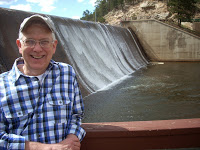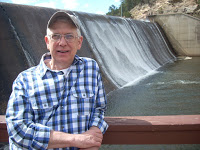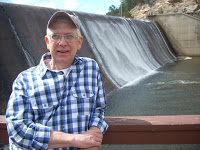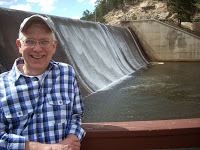Workout, by Phillip Hoyle
Reading, by Phillip Hoyle
Mom read to us kids with expression she had developed in high school drama. The five of us liked our introduction to children’s literature and to poetry—especially the poems she had memorized—and others she read out of books. It took a long time for me to start reading much on my own although I did like books, studying the pictures, reading the captions, and sometimes reading paragraphs. Still I didn’t read many books for myself until 8th grade when I discovered historical fiction, chapter books in story form. I soon became addicted to reading stories, a practice that continued uninterrupted until about age 42 when I went on a book fast. For a year I determined not to read any whole books.
My confession: During my fast I did re-read one favorite novel (perhaps Leslie Marmon Silko’s Ceremony) and then allowed myself one new novel (probably on a gay theme).
My success: I turned my free time into piano practice.
My practicality: I still consulted books when I had to teach a class or preach a sermon.
My learning: I already knew enough about the topics I was teaching so began relying more and more on my memory.
Perhaps I had read just too many novels beginning in junior and senior high school, during five years of undergraduate school, during three years of graduate school, and during two and a half years of graduate seminary. None of these books were required reading but they probably did help me keep balance in my life. I read many international books in translation thus broadening my view of the world. I read novels between semesters and years of schooling. I read on family vacations. Plus I read every assigned book and textbook and many more related to my studies.
I’m still at my reading although my practice has changed. I’ve added memoir to my list, also books about writing. I read quite a few books about visual arts as well, but now I spend more time writing and doing visual art projects. (Well I AM retired.) I’m reading books I borrow from several libraries, buy at bookstores, receive from family members, or find at ARC; and I keep reading and revising stories I have written. In my retirement I don’t read five books a week anymore but I often am reading five books at a time. In short, I continue my almost life-long practice of reading, and I love it.
Over the past several weeks I have been reading and re-reading Phillip Lopate’s To Show and To Tell, a fine book on essay writing. Lopate teaches non-fiction writing in the graduate program at Columbia University, NYC. On Tuesday I read through his very long suggested reading list and noted Benjamin Franklin’s Autobiography. On Wednesday I stopped by a used books store and was surprised to find the book on their shelves. Now I’m reading it, tickled by its style, intrigued by its information, analyzing its writing given what I’ve been learning from Lopate and other teachers, and taking note of how one of the founders of our country understood what he was doing. I never expected to read such a book but am so pleased I knew about it, stopped to look through it, and paid the five dollar price. I’m still reading. This book may take awhile.
© 6 November 2017
About the Author
Phillip Hoyle lives in Denver and spends his time writing, painting, and socializing. In general he keeps busy with groups of writers and artists. Following thirty-two years in church work and fifteen in a therapeutic massage practice, he now focuses on creating beauty. He volunteers at The Center leading the SAGE program “Telling Your Story.”
He also blogs at artandmorebyphilhoyle.blogspot.com
Stories that Shaped My Life
Early on the nursery rhyme “Georgie Porgie puddin’ and pie, kissed the girls and made them cry, when the boys came out to play Georgie Porgie ran away” spoke to me because my mom sometimes called me Georgie Porgie. I may have been that little boy. But in my version he liked looking at the boys he sometimes ran away from. He learned to play with them also. Well you can imagine more parts to that story.
James Fennimore Cooper’s The Last of the Mohicans grabbed my attention in 9th grade. I little understood it except to know that Indians were living where whites wanted to live and that Indians had Indian enemies and used the whites against them just as the whites used Indians against each other. While Cooper was a white, he opened the idea for me of becoming friends and benefitting from the Indians who knew the land so well and had their own ways of understanding and relating to it. Back then I understood little of the real conflict except to realize that these native people were being manipulated in ways I judged immoral. I was fascinated by the tribal ways of perceiving the world and appreciated their familial and tribal loyalties.
At church, missionaries told stories of carrying the gospel to other lands. I didn’t want to be a missionary but I did want to meet the people who understood the world so differently. This story structure challenged me to be open to others from far-away places and to appreciate the otherized perspectives of those who lived nearby. Dr. Victor Rambo’s story of finding a true and useful medical mission in India made sense to me. Son of missionaries, he wanted to help Indian people. His first attempts were unsuccessful. He earned a specialty in ophthalmology and returned to be very helpful for many years. Emulating him, his determination and courage, I realized his practical approach could help guide my own personal and ministerial development. I realized I needed to see real people with real needs.
For a long time the David cycle in the Bible, those stories about the boy, the young man, even the older man who became King of Israel, helped shape my moral life. I liked the David stories of loyalty, bravery, friendship, love, sin, and most important, of being a person one biblical author described as “a man after God’s own heart.” I liked that and its great flexibility. I was able to pattern myself somewhat like David (although I had little power and never murdered anyone for personal or political reasons), and I often used his stories in religious education resources I developed.
The stories of my Cambodian friend Narin Oum inspired me with his collecting and valuing of various religious traditions, seeing their connection in his own life journey. His conversion model was very tolerantly Asian Buddhist as he studied and became a Muslim and later a Christian. Hearing his story opened my imagination to new outcomes for my own life. I learned to value all my experiences and to let them instruct me how to understand my new life.
Ethan Mordden’s series of books about gay life in Manhattan with titles like I’ve a feeling we’re not in Kansas anymore, Buddies, and How’s your romance? helped shape my gay life. These stories, some of them extreme, opened me to a vast world of information that exceeded what I’d learned from other writers and from my gay friend Ted. I got a view of the diversity of what is sometimes called gay identity and community. I realized my own experiences would be a tiny part of what actually takes place. I did find my own space within this diverse world of my own people, one that embraces GLBTs and many other queer folk.
I’m sure I still little understand how all these stories came together even in my mind. Still they help me navigate my life and open my eyes to possibilities that were never directly part of the curriculum of any school I attended or any theological or philosophical approach I encountered.
I love stories and their power to transform. I hope to keep learning in my maturity and plan to keep listening to your stories told here at The GLBT Center of Colorado.
© 2 October 2017
About the Author
Phillip Hoyle lives in Denver and spends his time writing, painting, and socializing. In general he keeps busy with groups of writers and artists. Following thirty-two years in church work and fifteen in a therapeutic massage practice, he now focuses on creating beauty. He volunteers at The Center leading the SAGE program “Telling Your Story.”
He also blogs at artandmorebyphilhoyle.blogspot.com
Finding Your Voice, by Phillip Hoyle
I started out a soprano. Then on Sunday nights at church I decided to harmonize as an alto and learned to read the line and sing the part. When my voice cracked too many times in Glee Club, I became a tenor. I stayed with that for many years. Since I was a choir director, I learned to sing all the parts, SAT and B. In the choirs we worked hard to increase everyone’s tone and range using techniques I learned from one of my voice teachers. If a section was weak on a Sunday morning, I could bolster them with my own screaming. It may have horrified some people. Who knows?
About the Author
Phillip Hoyle lives in Denver and spends his time writing, painting, and socializing. In general he keeps busy with groups of writers and artists. Following thirty-two years in church work and fifteen in a therapeutic massage practice, he now focuses on creating beauty. He volunteers at The Center leading the SAGE program “Telling Your Story.”
He also blogs at artandmorebyphilhoyle.blogspot.com
Tears, by Phillip Hoyle
with Rafael Martínez who provided me my first experience of falling deeply,
hopelessly in love. Part of my preparation has been to study what writing
teachers say about memoir and, just as important, to read several memoirs. I
read Frank McCourt’s ’Tis, Kay Redfield Jamison’s An Unquiet Mind,
Mitch Albom’s Tuesdays with Morrie, several excerpts from other memoirs,
and am currently reading Paul Monette’s Borrowed Time.
was not yet ready to deal with organizing and writing about the experience of
love and loss. The grief was too keenly edged for me to be honest about myself
and fair to everyone else. The events took place fifteen years ago.
three weeks ago I started reading Monette’s AIDS memoir, a book I had read
years ago. I hoped I might learn a lot. A wealthy gay couple living in southern
California, Ivy League educated, driving around in a Jaguar, an attorney, a
Hollywood film writer living a rather high life seemed like a lot to take in. I
wondered if this story would even touch me.
a lot by Colorado AIDS Project. His doctors estimated he had about eight years
to go, but what they didn’t know was that he had full-term Hepatitis C. It was
diagnosed only three weeks before it killed him. Monette, while not my favorite
gay writer, skillfully took me to their home, clinic after clinic, test after
test, all experiences I knew too well for I went to such places with two friends
and with two lovers—just not in a Jaguar. Writing about Rafael while reading
this book opened my tear ducts, and I wondered: did I not cry enough fifteen
years ago? It seems likely.
one another and how practical and romantic we could be. I told him I would like
to meet his family before he ended up in the hospital. I was earnest though we
laughed. We thought we had time, but we were wrong. Too soon he was in the
hospital. There I met his younger brother, a very nice Mexican man who came north
on behalf of the family. The parents had learned that Rafael was gay and HIV
positive only six weeks before this hospitalization. The family’s life was in
crisis. Rafael got out of the hospital but then went back in with another
problem. Eventually more of the family arrived. I was caught between my lover
and his family; between Rafael’s insistence that they treat the two of us as a
family of our own, they being guests in our home, and what I saw so clearly in
his mother and father, the needs of shocked parents facing an illness they
didn’t understand and the possibility of losing their son altogether. In short,
I was pushed into an interpretive role of supporting both my lover and his
parents and siblings. I walked that tightrope, one that my ministerial experience
had so well prepared me to walk. And I was helpful. I cried but not much; there
were too many other people needing to be consoled and reasoned with and their
English was so poor and my Spanish functionally nonexistent.
Still Rafael was strong and helpful and insistent. I was so proud of him. He
took care of his family. He reached out to nurses who were having difficulty.
He reached out to me. And of course, I cried, but not very much, not enough I now
am sure.
hospital corridors, tests, last minute trips to favorite places, accommodation
to losses. I read; tears gather and fall.
time writing, painting, and socializing. In general, he keeps busy with groups
of writers and artists. Following thirty-two years in church work and fifteen
in a therapeutic massage practice, he now focuses on creating beauty. He
volunteers at The Center leading the SAGE program “Telling Your Story.”
Group Grief, by Phillip Hoyle
I Don’t Know, by Phillip Hoyle
time writing, painting, and socializing. In general, he keeps busy with groups
of writers and artists. Following thirty-two years in church work and fifteen
in a therapeutic massage practice, he now focuses on creating beauty. He
volunteers at The Center leading the SAGE program “Telling Your Story.”
Empathy, by Phillip Hoyle
As a college student I learned a distinction between sympathy and empathy. The contrast arises from the two different Greek words. It also is influenced by psychoanalytic theory and practice. In most discussions empathy is considered to be more finely tuned than sympathy. As a minister I was called upon to do many tasks including hospital and care-home calls on members of the church. I did this work thoughtfully and, I believe, with sympathy, and on good days a measure of empathy! People liked my visits and humor. We laughed and prayed together.
In the church work I was motivated as much by duty as by sympathy and empathy. And I was appropriately trained to be helpful with patients and shut-ins. Apparently I provided sufficient care in my communications and mainly in the fact I showed up at all. Perhaps that is the way of it when one has too many people to serve.
The caring emotion for me occurred most clearly when I was in a hospital room with someone having a difficult time. I also noticed how my empathy was amplified when I liked the person, occasions in which other emotions and feelings added to what I was experiencing, for instance, the time an elder woman introduced me to her nephew when she and I were the only persons present made me wonder at the drugs the medics had given her for pain and the need to suppress a feeling of humor at the situation. (I was fine; she got better.)
I visited a good looking single young man who had a stubborn bone infection. I know that a sexual attraction increased my sense of his pathos. It alerted me to how others might prize him emotionally and their sense of fear surrounding his illness. My empathy extended to his family and friends. He eventually did recover after receiving loads of highly potent antibiotics.
Several times I visited an elder woman, very worldly and professional, with a bright personality and deep determination to recover from a major stroke. One day several weeks into treatment she appeared to have made a turn for the better. I was excited on her behalf and expressed how much better she looked. She tempered my enthusiasm, though, by saying, “Phillip, I finally felt up to putting on my makeup.” We laughed together. I said, “You are getting better.”
My empathy was sincere in all these cases yet certainly amplified by other emotions. And in all these visits I was present because I was a minister from their church.
One inactive church member, a real sot, was driving home from the VFW on an icy night and being rather drunk, crashed his car into the west entry to the church building. I didn’t see the car but did see the damage to the steps and more. The Sr. Minister, Jack, wasn’t sure what to do. I volunteered, “I’ll go to the hospital and see how he is.” I’d never met the man and really didn’t know much about alcohol or alcoholism. I went in simply as a visiting minister. “So they sent you,” he said eyes twinkling.
“Yeah. It’s my day to make the rounds,” I said to underplay the situation. I asked how he was doing. He said, “Fine,” and seemed totally sober at that point, perhaps from the trauma. I realized he might even feel ill at ease and said, “You just rest and recover.” I shook his hand, smiled saying, “It’s a pleasure to meet you, and don’t worry about the church stuff.” I may have visited him later, I have no recollection. I never saw him outside the hospital, certainly not in church. His collision with the front steps was no conversion.
Was I sympathetic or empathetic? I have no real idea. As a massage therapist I felt empathy with most of my clients in their pains and diseases but not always in their gripes and in some of their expressed needs. I did smile often and sometimes cried. I mostly tried to deliver an effective massage and must have done that pretty well. Many of my clients came to me for over fourteen years. Perhaps I was sufficiently empathetic. And my real hope is that I was never just plain old pathetic in these contacts.
© 27 Nov 2017
About the Author
Phillip Hoyle lives in Denver and spends his time writing, painting, and socializing. In general he keeps busy with groups of writers and artists. Following thirty-two years in church work and fifteen in a therapeutic massage practice, he now focuses on creating beauty. He volunteers at The Center leading the SAGE program “Telling Your Story.”
He also blogs at artandmorebyphilhoyle.blogspot.com
Revenge, by Phillip Hoyle
Sages of the East and West, North and South have advised against revenge. I’m sure we can add SAGES of the Rockies to the list of wise ones. Revenge will never satisfy. It begins a feud that will never end. It will define a life, not improve it. I’m old but have no experience of revenge and thus no story to tell.
But I have noticed something I want to tell you about. You’d never believe how much sex takes place in our backyard and the alley beyond. It’s a wonder we haven’t been pushed out of the neighborhood so seedy is that space in a rather quiet district of Denver where more and more children are being born and reared. I won’t try to justify what takes place in our backyard but simply describe it. Frankly, I have been surprised although I’m not sure why. Perhaps I am just a tiny bit jealous? Probably I should consider it an inspiration. I do want to mention before I continue this story that in it I’m simply a voyeur.
Sometimes out there couplings occur; occasionally a ménage a trios. I’ve seen necking that surpasses anything I ever saw or did on the top of Bluemont, that Kansas State University make out spot for undergraduates and who knows who else. I sometimes hear screams and can never determine if they are from pain or pleasure or simply the intensity of the moment. A rhythmic chant sometimes seem to say, “Won’t you come and put it to me?” Sometimes it is repeated over and over until, for me at least, it loses its allure. But the beat goes on. I’ve seen dances, flurries of activity, showing off, flirting, teasing, urging, and suggesting. I’ve seen mountings and heard noise making I don’t know how to describe. I’ve seen dirty dancing that more than rivals what I saw for years on Saturday nights at The Denver Compound and Basix dance floor. I’ve seen things done out in the open that would get a Republican to warm up.
Well, I can tell it’s time to end this tale of what my prim sister would call lewd conduct, but it seems unadvisable to criticize Mother Nature right out there in the open. The sparrows started it all years ago. Then the flickers got deep into the necking dance. You’d never imagine how noisy that gets or how enticing. Now robins come around and just yesterday some very excited chickadees—a ménage a quatre—put on the most spectacular and noisy demonstration I’ve ever seen. It’s wild out there in the backyard. What’s it like in your neighborhood? Inspiring? Invite me over.
© 14 August 2017
About the Author
Phillip Hoyle lives in Denver and spends his time writing, painting, and socializing. In general he keeps busy with groups of writers and artists. Following thirty-two years in church work and fifteen in a therapeutic massage practice, he now focuses on creating beauty. He volunteers at The Center leading the SAGE program “Telling Your Story.”
He also blogs at artandmorebyphilhoyle.blogspot.com









